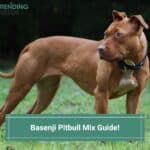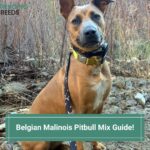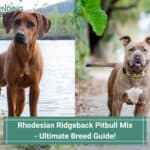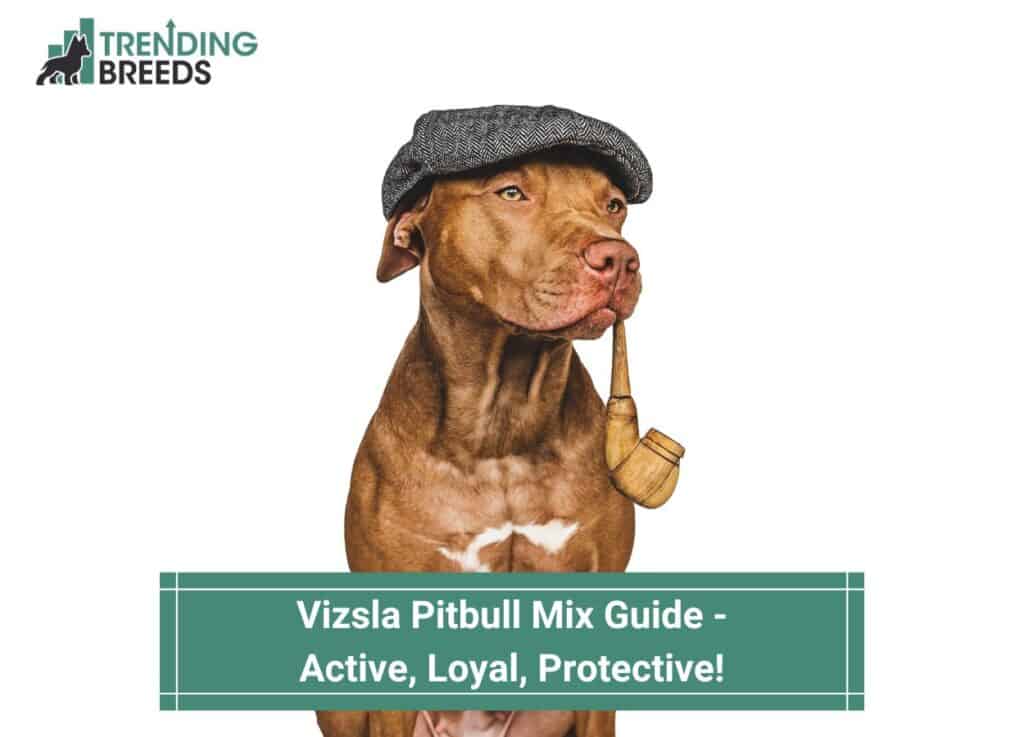
The Vizsla Pitbull mix is a relatively uncommon hybrid dog with two incredible parent breeds. Athletic, loyal, and protective, this mix is not for an inexperienced or weak owner.
However, with strong leadership and an owner with the time to train and socialize a Vizsla Pitbull mix, the dog can be a babysitter, best friend, hiking buddy, and all-around goofball.
In this blog post, we’ll look at the two fascinating parent breeds this mix comes from, the likely characteristics of the mix, and what to look out for.
Other articles you would like: Do Vizslas Have Any Health Issues? and Rhodesian Ridgeback Pitbull Mix.
Table of Contents
The Vizsla
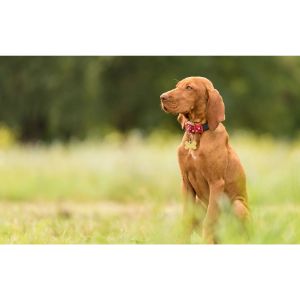
Appearance and temperament are two of the most important factors to consider when choosing a dog breed, and the Vizla does not disappoint on either front. Vizslas are medium-sized dogs with short, dense fur that can be either rust or chestnut brown.
They have long ears hanging close to their face and almond-shaped eyes, giving them an almost humanlike expression. But don’t let their cute exterior fool you—these dogs are all muscle beneath that soft fur and are not afraid to use it.
Vizslas were originally bred for hunting in Hungary and retain those instincts today. They’re incredibly active dogs that need plenty of exercise, which makes them the perfect running or hiking buddy.
And if you’re looking for a guard dog, the Vizla is an excellent choice. They’re naturally protective of their family and home, but they won’t bark unnecessarily or be aggressive without reason.
Of course, no discussion of the Vizla breed would be complete without mention of their loyalty. These dogs form strong bonds with their owners and are naturally inclined to please them.
They’re quick learners who excel at obedience training but also have a mischievous streak—be prepared for some mischief if you leave them home alone for too long!
The Vizsla needs plenty of exercise and attention, and they’re not well suited to living in small apartments or houses without a yard. Like all hunting dogs, they can have a high prey drive and chase smaller animals.
Vizslas have short, sleek coats and are moderate shedders with modest grooming needs. They have floppy ears that must be cleaned more regularly than dogs with perky ears.
They are medium to large dogs that stand about 23 to 27 inches at the shoulder for males and 21 to 24 for females. In addition, males can weigh up to 66 lbs while females up to 55 lbs.
The Pitbull Terrier
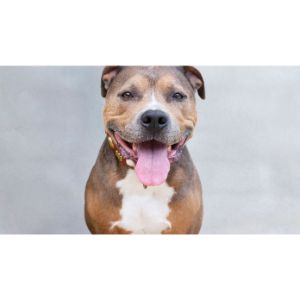
The Pitbull Terrier is a type of dog that is often misunderstood. People tend to think that Pitbulls are aggressive and dangerous, but this couldn’t be further from the truth!
Pitbulls are very friendly and loving dogs. They are also great with children and make excellent family pets.
The origins of the Pitbull Terrier can be traced back to England, where they were originally bred from Bulldogs for bull-baiting and dog fighting.
When these activities were outlawed in 1835, many dogs were brought to America, where they were used for farm work and as catch dogs for hogs. They were also popular family pets due to their loyalty and affectionate nature.
Pitbulls have a reputation for being aggressive, but this couldn’t be further from the truth! Yes, they are powerful dogs, but they are not naturally aggressive.
They are known for being gentle and loving with children. Pitbulls require plenty of exercise and stimulation, or they can become bored and destructive. A good way to keep your Pitbull happy and healthy is to take them for long walks or runs daily.
They have short coats and modest grooming needs. A brush every few days and a bath every once in a while are enough for these low-maintenance dogs.
They are medium-sized dogs, stand 17 to 21 inches at the shoulder, and weigh 30 to 60 pounds.
They come in many colors and can be brindle, black, blue, fawn, red, and white, with or without markings.
The Vizsla Pitbull Mix
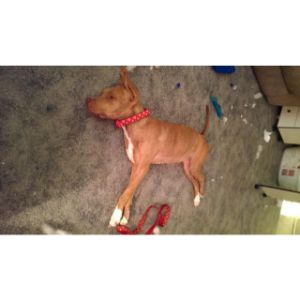
The Vizsla Pitbull mix enjoys the best characteristics of the two parent breeds. With the athleticism and hunting skills of the Vizsla and the stocky, muscular build of the Pitbull, the mix is likely to be an active, athletic dog that is closely bonded to its family.
The Vizsla Pitbull Mix Temperament
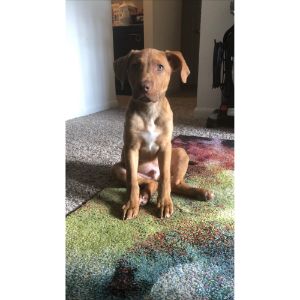
This mixed breed inherits the best traits from both parents. Friendly, affectionate, and loving dogs make great family pets.
However, they can also be stubborn and headstrong, requiring patience and consistent training. Early training and setting boundaries are crucial, especially in this strong-willed mix.
It helps your dog to understand what is expected of him or her. In addition, it establishes you as the pack’s leader, which is a natural structure for dogs.
Early and consistent training also helps develop a bond between you and your Vizsla Pitbull mix and prevents behavioral problems from developing.
They are also strong chewers, requiring sturdy toys and plenty of chewing bones. A bored dog with nothing to chew on is a recipe for many of your destroyed possessions!
Extensive socialization is also key.
While the Vizsla Pitbull mix isn’t known to be particularly fearful, properly socialized dogs learn how to interact with other dogs and people and develop the skills they need to be confident and well-rounded members of society.
Unfortunately, not all dogs are lucky enough to have this opportunity. Not socialized dogs can become fearful and anxious, leading to aggression and other problem behaviors.
That’s why it’s so important to socialize your dog from an early age. Exposing them to different people, places, and situations will help your Vizsla Pitbull mix develop into happy, well-adjusted adults.
The Vizsla Pitbull Mix Size And Appearance
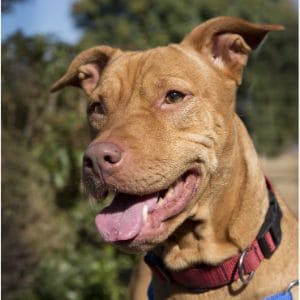
The Vizsla Pitbull mix will have a short coat as both parent breeds sport short, sleek coats. The mix will have a golden brown or rust-colored coat if they take after the Vizsla parent.
However, if they take after the Pitbull parent, they can have a wide range of coat colors from white, cream, fawn, or rust.
Their short coats will need minimal grooming, and a brush every few days would be enough to rid the coat of dead fur and dander.
They will be medium-sized dogs that can stand about 19 to 24 inches at the shoulder and weigh 40 to 60 lbs.
The Vizsla Pitbull mix is an athletic, powerful dog. If it takes after the Pitbull parent, it will be stocky and muscular, while if it takes after the Vizsla, it will have a similar muscular structure but be lankier and leaner.
The Vizsla Pitbull Mix Exercise Needs
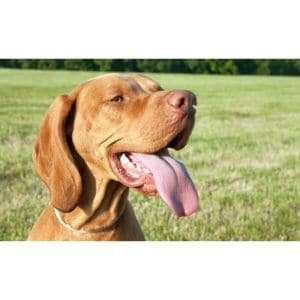
The Vizsla Pitbull mix is an active dog that will need at least one or two hours of exercise daily. A mere stroll around the block won’t be enough! Try a vigorous game of fetch or frisbee to keep this mix happy and burn off all that excess energy.
Agile and powerful, the mix will be an excellent hiking or running partner. You can also try to enroll in agility classes which athletic dogs will enjoy.
The Vizsla Pitbull mix is an intelligent dog that will enjoy learning new things, so you can try interactive toys like a treat-dispensing ball or a Kong. They are powerful chewers, so get toys that will stand up to enthusiastic jaws!
The Vizsla Pitbull Mix Lifespan And Potential Health Problems
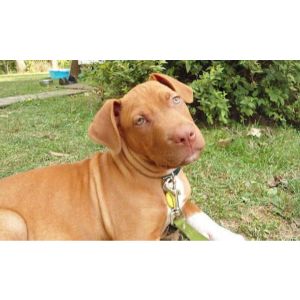
The Vizsla Pitbull mix is a generally healthy dog that can live up to 15 years. However, like all mixed breeds, they will, unfortunately, inherit the genetic predispositions of both parent breeds.
Hip Dysplasia
Hip dysplasia is a condition that affects the hip joint and is common in larger dogs. The hip joint is a ball-and-socket joint; in healthy dogs, the ball fits snugly into the socket. However, the ball is not properly seated in the socket in dogs with hip dysplasia.
This can cause pain and lameness, and it can also lead to arthritis. Hip dysplasia is often hereditary but can also be caused by injury or infection. Treatment options include weight management, physical therapy, and surgery.
Elbow Dysplasia
Similar to hip dysplasia, elbow dysplasia is a condition that affects the joints of a dog’s elbow. Several factors can contribute to elbow dysplasia, including genetics, nutrition, and weight.
If your dog is genetically predisposed to the condition, there isn’t much you can do to prevent it.
However, if poor nutrition or excess weight is the cause, there are steps you can take to help your dog. Ensuring your pet gets the right balance of vitamins and minerals will help keep their joints healthy.
Also, keeping them at a healthy weight will reduce the amount of strain on their elbow joints.
Congenital Heart Defects
The Pitbull Terrier is susceptible to congenital heart defects. These defects can range in severity; some may not be detectable until later in life. The most common congenital heart defect in Pitbulls is a hole in the heart.
This can occur between the heart’s left and right chambers or upper and lower chambers. Other common defects include valves that don’t function properly or malformed blood vessels.
Heart defects can cause various symptoms, including coughing, exercise intolerance, and fainting.
Progressive Retinal Atrophy (PRA)
Progressive retinal atrophy (PRA) is a degenerative eye disease that affects dogs. The disease is characterized by the gradual loss of photoreceptor cells in the retina, leading to blindness.
A genetic mutation can cause PRA, but other factors, such as diabetes or trauma, can also trigger it.
There is no cure for PRA, but treatments can help slow its progression and improve the quality of life for affected dogs. In some cases, surgery can be used to remove the diseased retina and replace it with an artificial one.
However, early detection and prevention are the most effective way to manage PRA. Regular eye exams can help identify the disease in its early stages when treatment is most likely successful.
Canine Epilepsy
The Vizsla is prone to epilepsy, a neurological disorder that can cause seizures. These seizures can vary in severity, from mild to severe, and can occur at any age. While the exact cause of canine epilepsy is unknown, it is believed to be hereditary.
There are several different types of epilepsy, each with its own symptoms. Treatment for canine epilepsy typically includes medication, which can help to control seizures.
Canine epilepsy is a serious condition, but most dogs can live normal, happy lives with proper treatment.
Dental Disease
Periodontal disease affects about 80% of all dogs above the age of three. This occurs when bacteria build up in the gum line and cause inflammation.
If left untreated, periodontal disease can lead to tooth loss and damage to the bones and tissues surrounding the teeth.
The good news is that periodontal disease is preventable with proper dental care.
This means brushing your dog’s teeth regularly and taking them to the vet for professional cleanings. It would help if you also watched for signs of oral discomfort, such as excessive drooling or difficulty eating.
Hypothyroidism
Vizslas are also prone to hypothyroidism, which affects the thyroid gland. The thyroid gland is located in the neck and produces hormones that regulate the body’s metabolism.
If the gland doesn’t produce enough hormones, it can lead to various problems, including weight gain, fatigue, and dry skin.
Hypothyroidism is relatively common in dogs, especially middle-aged and older dogs. Symptoms can vary depending on the severity of the condition, but they may include weight gain, lethargy, and dull coat.
Frequently Asked Questions
Are pitbulls innately aggressive?
These dogs are not innately aggressive, but they do tend to be less tolerant of other animals.
Do pitbulls suddenly snap?
These dogs do not just snap. Most of their aggressive displays are caused by something.
Is the Vizsla a good family dog?
The Vizsla is an excellent family dog, but probably would not do well around small children.
Vizsla Pitbull Mix Guide
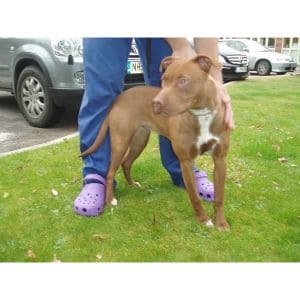
The Vizsla Pitbull mix is a loyal, protective dog that will make a wonderful addition to many families.
However, they are not suited for sedentary or first-time owners. If you have the time and energy to exercise and socialize with this incredible mix, you’ll have a loving companion for many years to come!
You will also like:
For more Vizsla Mixes, check out the video below:

